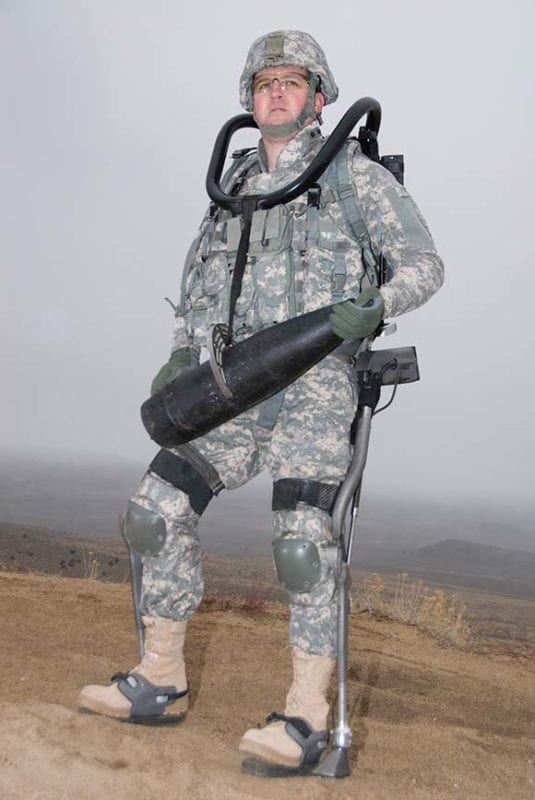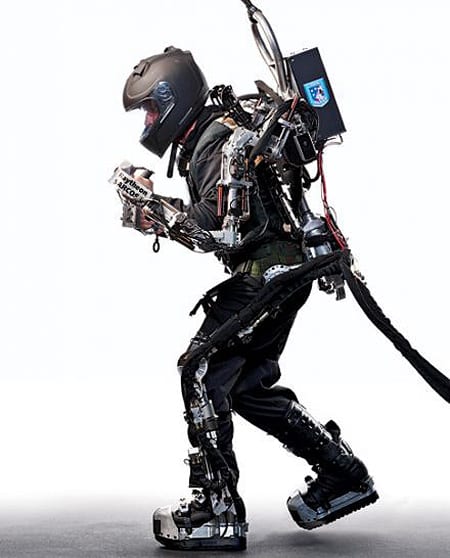If you could imagine the best tool ever, would you have the creativity to include an Iron Man suit? Right now there are two US weapons design firms working hard to get a contract to develop military exoskeletons. These are accessory suits that soldiers would wear to allow them to lift more, run faster, fight better than the human body is capable of alone. The two companies, Utah’s XOS (backed by Raytheon) and California’s HULC (backed by Lockheed) seem to be locked in a dead heat – at least they are now that Raytheon has rolled out its 2.0 version of their powered suit. Here’s some video of it in action and Raytheon even invited Clark Gregg (Agent Phil Coulson from the Iron Man movies) was invited to try it on:
The two suits are very different – and at very different stages of development. Lockheed’s HULC is a more refined product, running on Lithium-ion batteries and actually going through testing with soldiers in the US military, but it’s also more of a heavy-lifting device, offering no real capabilities beyond that at present. Raytheon’s XOS 2.0 seemed to specifically time their release to coincide with Iron Man 2 on DVD, having made their second stab at the product lighter, faster and stronger – while using 50% less power.
The XOS seems more like a super soldier suit and less like a heavy-lifting accessory, especially given its arm mechanics and the nature of how it assists more parts of the body. Unlike the HULC, which offers only over-shoulder lifting straps to assist its wearers’ arms, the XOS has powered, articulating upper limbs as well as mechanically-assisted legs and back. The design philosophies seemed to go in different directions from the start – and the XOS just seems more ambitious:

- HULC (Human Universal Load Carrier) – make it small, provide for heavy lifting, get to market faster
- XOS (eX-O-Skeleton) – create a system that could truly augment a soldier’s ability to do everything his body does naturally
The XOS just seems to tackle more, but what’s cooler: a fully completed Ford Taurus or a work-in-progress futuristic Delorean? The major downside of the XOS is that, for now at least, it still runs tethered to a power source. This is something that Raytheon is counting on changing as soon as they can optimize it further and, of course, as battery technology gets better and more advanced. It doesn’t look like this is exactly around the corner, however as even Raytheon thinks the required tech is still a decade out.
When Raytheon was asked why they don’t use li-ion, they responded that they felt the batteries were extremely dangerous. If one gets breached, it can explode and cause a fireball that’s similar to a magnesium flare. What was perplexing was that they instead opted to focus on the internal combustion engine to power the hydraulics.
Internal combustion engine? Wha?!?! Get some kevlar and move on, sir. Soldiers are meant to risk their lives, and lithium-ion batteries detonating doesn’t seem like much of an added a risk when you’re talking about being under fire, carrying explosives and loading bombs onto airplanes and helicopters… Of course battery technology DOES have to get better, and who wants to bail out of a multi-million dollar suit when the batteries go dead in a war zone? In that respect, Iron Man nailed it – we seem to need some sort of super, as-yet-undiscovered power source before these technological tools can really delve into the world of science fiction and come to life in the real-world.



